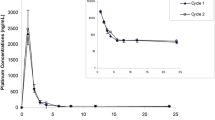Abstract
Background. In a phase I clinical trial of oxaliplatin (OPT) in combination with paclitaxel (PXL), a pharmacokinetic interaction was observed when OPT was given as a 2-h i.v. infusion followed by a 1-h i.v. infusion of PXL. The purpose of this study was to use a rat model to evaluate whether the pharmacokinetic interaction between OPT and PXL is dosing sequence-dependent.
Methods. One group of rats was given OPT as a 2-h i.v. infusion followed by a 1-h i.v. infusion of PXL formulated in 50% Cremophor EL (CrEL)/50% ethanol (OPT→fPXL), similar to the current phase I clinical protocol. In a second group of rats, the fPXL was infused first to reach a quasi-steady-state plasma level of PXL, followed by an i.v. bolus dose of OPT (CIfPXL→OPT). In a third group of rats, fPXL was replaced with the formulation vehicle, CrEL, which was infused in the same manner as in the second group. Each combination was accompanied with a control of either OPT alone or with replacement of PXL with dextrose 5% in water (CID5W→OPT). The total platinum (Pt) levels in plasma and plasma ultrafiltrate were measured by a validated inductively coupled plasma mass spectrometry (ICPMS) method. The protein binding, red blood cell (RBC) uptake and urinary elimination of Pt were also examined in each group of rats.
Results. The concentration-time profiles of plasma Pt and ultrafiltrable Pt followed triexponential decays in all groups of rats. In the rat receiving OPT→fPXL, the terminal elimination rate constant (γ) of plasma Pt increased, with essentially no change in the total body clearance (CL) and the AUC value, when compared to those without PXL infusion (CID5W→OPT). The steady-state volume of distribution (Vss) of the ultrafiltrable Pt also showed an increase in the combination group receiving OPT→fPXL (P<0.01). These results were similar to those from the clinical trial, although the magnitude of change was less. However, in the CIfPXL→OPT group, both CL and Vss of Pt in plasma and plasma ultrafiltrate decreased, with corresponding increases in AUCs (P<0.01). The 24-h urinary elimination of total Pt increased in both combination groups, irrespective of the dosing sequence. No difference in protein binding of Pt was observed among the groups. There was a decrease in RBC uptake in the presence of steady-state level of fPXL, but the same was not observed in the OPT→fPXL group. Additionally, similar results were observed with OPT in combination with CrEL alone.
Conclusions. These results suggest that alterations in the pharmacokinetics of OPT by fPXL are dosing sequence-dependent and mainly caused by the formulation vehicle CrEL. It is suggested that the dosing sequence of fPXL followed by OPT would be more clinically favorable because it would prolong the residence of OPT in systemic circulation. It is further recommended that the use of other formulations of PXL without CrEL or docetaxel would avoid the complication effect of CrEL.
Similar content being viewed by others
Author information
Authors and Affiliations
Additional information
Electronic Publication
Rights and permissions
About this article
Cite this article
Liu, J., Kraut, E.H., Balcerzak, S. et al. Dosing sequence-dependent pharmacokinetic interaction of oxaliplatin with paclitaxel in the rat. Cancer Chemother Pharmacol 50, 445–453 (2002). https://doi.org/10.1007/s00280-002-0531-6
Received:
Accepted:
Issue Date:
DOI: https://doi.org/10.1007/s00280-002-0531-6




